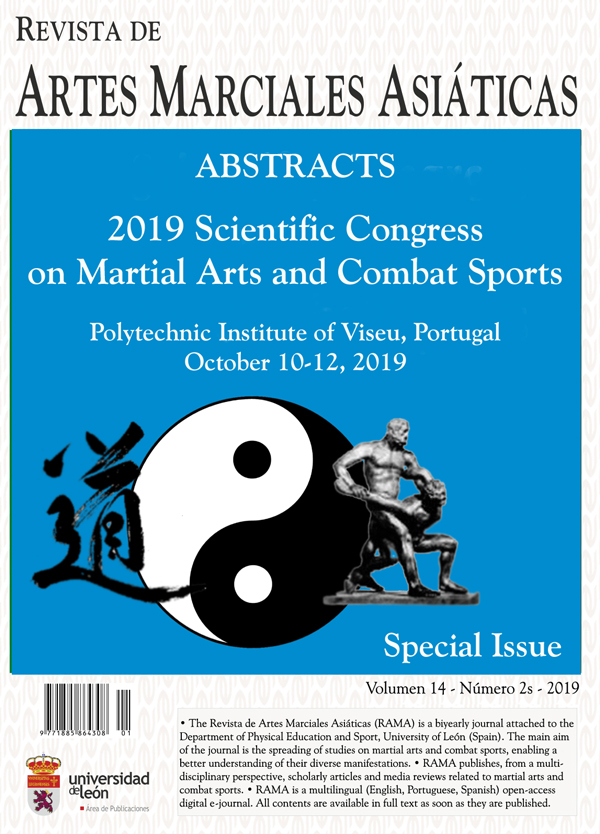The gist and significance of wrist work in the old Polish fencing sabre based on selected techniques of cuts and thrusts
DOI:
https://doi.org/10.18002/rama.v14i2s.5961Palabras clave:
Martial arts, wrist movements, carpal bones, old Polish fencing, hussar sabre, short stick fightingResumen
The aim of this study was to determine the essence and importance of wrist movements for the old Polish sabre fencing. Analysis of available writings, work with old Polish fencing students in the years 2009 – 2019, empirical interpretation of the described techniques. The analysis of available writings, the work with old Polish fencing students in the years 2009 – 2019, and empirical interpretation of the described techniques were used. Results showed that wrist work was essential for the execution of a number of historical techniques. It allowed to gain control over the opponent’s blade and prevail in the clash. Further research on old Polish fencing is necessary.
Descargas
Métricas alternativas
Citas
Bochenek A., & Reicher, M. (1968). Anatomia człowieka T.I, s. 433. Warszawa: PZWL.
Borysiuk, Z. (2005). The historical transformation of sabre fencing. Ido – Ruch dla Kultury / Movement for Culture, 5, 9-15.
Cynarski, W. (2004) About the art of fencing. Remarks on classical fencing. Ido – Ruch dla Kultury / Movement for Culture, 4, 29-44,
Czajkowski, Z. (2007). Fencing in ancient Poland. Ido – Ruch dla Kultury / Movement for Culture, 7, 55-64.
Ivanovsky, M. (1834). Nouveau Systéme d’Escrime pour la cavalerie, fondé sur l’emploi d’un nouveau sabre inventé par M. Ivanowski, officier polonais. Paris: Poussielgue
John, A., & Musiolik, A. (2010) Analiza kinematyczna palców ręki. Retrieved from http://www.kms.polsl.pl/mi/pelne_9/15.pdf
Łaski, S. (1599). Spraw i postępków rycerskich i przewagi opisanie krótkie, opus post mortem. Lviw, Poland
Maroteaux, R., J. (2011). Special sabre polonais & japonais. Aiki Goshin Do Kaishi, (55), 12-22.
Maroteaux, R., J. (2019). Special sabre polonais. Aiki Goshin Do Kaishi, (77), 23-27.
Marsden, R. (2015). Polish Saber. The use of the Polish Saber on foot in the 17th century. Cambridge: Tyrant Industries.
Miklaszewski J. (n.d.). Polish Historical Fencing. Retrieved from https://www.youtube.com/watch?v=ANPrQ4N4HNw
Sawicki, Z. (2014). Influence of the Polish martial art onto European armies in the 18th and 19th centuries. Ido Movement for Culture. Journal of Martial Arts Anthtopology, 14(4), 3-13. doi: https://doi.org/10.14589/ido.14.4.2
Sawicki, Z. (2008). Michała Starzewskiego traktat „O szermierstwie” w interpretacji Zbigniewa Sawickiego. Zawiercie: Wydawnictwo Signum Polonicum.
Sawicki, Z. (2005). Palcaty. Podręcznik dla początkujących. Zawiercie: Wydawnictwo Signum Polonicum.
Sawicki, Z. (2019). Palcaty Staropolska szermierka na kije (Studium historyczne z dziejów kultury fizycznej). Author’s collection materials from doctoral dissertation.
Sawicki, Z. (2011). PolishMartialArts – Signum Polonicum: Historical background and the main plots of the system. Ido Movement for Culture. Journal of Martial Arts Anthtopology, 11(2), 38-46.
Sawicki, Z. (2012). Traktat szermierczy o sztuce walki polską szablą husarską część druga. Zawiercie: Wydawnictwo Napoleon V.
Sawicki, Z. (2004). Traktat szermierczy o sztuce walki szabla husarską. Podstawy. Zawiercie: Wydawnictwo Signum Polonicum.
Sieniawski. B, (2013). The saber’s many travels. (The origins of cross cutting-art). Retrieved from https://hroarr.com/article/the-sabers-many-travels-the-origins-of-the-cross-cutting-art/
Sikora, R. (2019). Husaria. Duma polskiego oręża. Kraków, Poland
Zabłocki, W. (2001). Polskie sztuki walki - miecz oburęczny i szabla husarska. Podkowa Leśna: Wydawnictwo AULA.
Descargas
Publicado
Cómo citar
Número
Sección
Licencia
Derechos de autor 2019 Leonard Marynowski

Esta obra está bajo una licencia internacional Creative Commons Atribución-NoComercial-CompartirIgual 4.0.
Los autores que publican en esta revista están de acuerdo con los siguientes términos:
- Los autores ceden de forma no exclusiva los derechos de explotación (reproducción, distribución, comunicación pública, transformación) a la Universidad de León, por lo que pueden establecer, por separado, acuerdos adicionales para la distribución no exclusiva de la versión de la obra publicada en la revista (por ejemplo, alojarlo en un repositorio institucional o publicarlo en un libro), con un reconocimiento de su publicación inicial en esta revista.
- Este trabajo se encuentra bajo la Creative Commons Attribution-NonCommercial-ShareAlike 4.0 International License. Puede consultarse desde aquí la versión informativa y el texto legal de la licencia.
- Se permite y se anima a los autores a difundir electrónicamente las versiones pre-print (versión antes de ser evaluada) y/o post-print (versión evaluada y aceptada para su publicación) de sus obras antes de su publicación, ya que favorece su circulación y difusión más temprana y con ello un posible aumento en su citación y alcance entre la comunidad académica.











